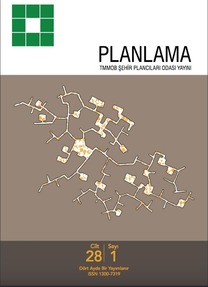Yapılı Çevrelerde Zamana Bağlı Mekansal Değişimin Analitik Olarak Ölçülmesi ve Görselleştirilmesi: İstanbul Beyazıt Meydanı Örnek Alan İncelemesi
Analytical Measuring and Visualization of Spatio-Temporal Change in Built Environments: Beyazıt Square Case Study Area in Istanbul
___
- Alexander, C. (1965). A city is not a tree. Architectural forum 122/1 and 122/2, (Part1)58-61 and (Part2)58-62.
- Alexander, C., Neis, H., Anninou, A., & King, I. (1987). A New Theory of Urban Design. New York: Oxford University Press.
- Alexander, C. (1963). Notes on the Synthesis of the Form. Cambridge, Massachusetts:
- Harvard University Press. Alexander, C. (2002-2005). The Nature of Order: An Essay on the Art of Building and The Nature of the Universe, Book One, the Phenomenon of Life.
- San Francisco: Berkeley, California: Center for Environmental Structure. Alexander, C. (1979). The Timeless Way of Building. New York: Oxford University Press.
- Ayvazoglu, B. (2012). Üçüncü Tepede Hayat - Beyazıt Meydanı’nın Derin Tarihi. İstanbul: Kubbealtı Neşriyatı.
- Bailey, K. D. (2015, May). Entropy Systems Theory. Retrieved from Encyclopedia of Life Support Systems (EOLSS): http://www.eolss.net/ebooks/ Sample%20Chapters/C02/E6-46-01-04.pdf
- Bohm, D. (1980). Wholeness and implicate order. London: Routledge. Claramunt, C. (2005). A spatial form of diversity. In A. G. Cohn, & D. M. Mark, COSIT, LNCS vol. 3693 (pp. 218-231). Heidelberg: Springer. Cullen, G. (1961). Townscape. London: Architectural Press.
- Eyice, S., & Kuban, D. (1993). Dünden Bugüne İstanbul Ansiklopedisi. İstanbul: Ministry of Culture & Foundation of History.
- Freely, J. (2011). A History of Ottoman Architecture. WIT. Harris, J. (2012). Fractal Architecture. China. Hillier, B., & Vaughan, L. (2007). The city as one thing. Progress in Planning, 67 (3), 205-230.
- IMM. (2012). Beyazit Square Urban Design Project Unpublished Report. Istanbul: Department of Urban Design, Istanbul Metropolitan Municipality. Istanbul 4th Protection Board for Cultural Assets. (2013). Board Evaluation Report (No: 20249679/715). Istanbul: Unpublished Report.
- Jacobs, J. (1961). The Death and Life of Great American Cities. New York City: Random House.
- Jat, M. K., Garg, P. K., & Khare, D. (2007). Monitoring and Modelling of Urban Sprawl Using Remote Sensing and GIS Techniques. International Journal of Applied Earth Observation and Geoinformation, 26- 43. Retrieved from http://www.sciencedirect.com/science/article/pii/ S0303243407000335
- Jiang, B. (2017, January 15). Geographic space as a living structure for predicting human activities using big data. Retrieved from ResearchGate: https://www.reserachgate.net/publication/312332540
- Jones, T. (2010, November 30). Data visualization with Processing, Part 1: An introduction to the language and environment. Retrieved 2015, from ibm.com: http://www.ibm.com/developerworks/library/os-datavis/osdatavis-pdf.pdf Karaali, D., & Karagöl, A. (2013). The imperfection of the incomplete timeless urban space. ITU A-Z Journal of Architecture Vol.10/1, 17-36.
- Karlström, A., & Ceccato, V. (2002). A new information-theoretical measure of global and local association: S. The Review of Regional Research 22, 13-40. Kempf, P. (2009). You Are the City [graphic]: Observation, Organization, and Transformation of Urban Settings. Baden, Switzerland: Lars Müller Publishers.
- Köhler, W. (1947). Gestalt Psychology: An Introduction to New Concepts in Modern Psychology. New York: LIVERIGHT.
- Leibovici, G. D. (2009). Defining Spatial Entropy from Multivariate Distributions of Co-occurrences. In K. S. Hornsby, & e. a. (eds), Spatial Information Theory (pp. 392-404). aber W’rach: Springer-Verlag Berlin Heidelberg.
- Li, H., & Reynolds, J. (1993). A new contagion index to quantify spatial patterns of landscapes. Landscape Ecology 8, 155-162.
- Li, Z., & Huang, P. (2002). Quantitative measures for spatial information of maps. International Journal of Geographic Information Science 16(7), 699-709. Lynch, K. (1960). Image of the City. Cambridge: The Technology Press & Harvard University Press
- Maitre, H., Bloch, I., & Sigelle, M. (1994). Spatial entropy: a tool for controlling contextual classification convergence. Proceedings of IEEE International Conference on Image Processing ICIP vol. 2, 212-216.
- Mandelbrot, B. (1977). Fractals: Form, Chance, and Dimension. W. H. Freeman & Company.
- Mandelbrot, B. (1982). The Fractal Geometry of Nature. San Franciso: W. H. Freeman and Company.
- Marshall, S. (2012). Science, pseudo-science and urban design. Urban Design International, V17, Issue 4, 257-271. Mehaffy, M., & Salingaros, N. A. (2011, October 24). Point of View. Retrieved from metropolismag.com: http://www.metropolismag.com/
- Point-of-View/October-2011/The-Wholeness-Generating-Technologyof-Christopher-Alexander/
- Microsoft. (2015, December 10). C# Programming Guide. Retrieved 2016, from Microsoft Developer Network: https://msdn.microsoft.com/enus/library/67ef8sbd.aspx Müller-Wiener, W. (2002). İstanbul’un Tarihsel Topoğrafyası. İstanbul: Yapı Kredi Yayınları.
- Shannon, C. E. (1948). A Mathematical Theory of Communication. Bell System Technical Journal 27: 3, 379-423.
- Shannon, C. E. (2001). A Mathematical Theory of Communication. ACM SIGMOBILE Mobile Computing and Communications Review V.5/1, 3-55.
- Tobler, W. (1970). A computer movie simulating urban growth in the Detroit region. Economic Geography, 46(2), 234-240.
- Tupin, F., Sigelle, M., & Maitre, H. (2000). Definition of spatial entropy and its use for texture discrimination. International Conference on Image Processing Vol. 1, (pp. 725-728).
- Waguespack, L. (2010). Thriving Systems Theory and Metaphor-Driven Modeling. Springer.
- Wang, T. (2016). Information & Entropy (Comp 595 DM). Retrieved from http://www.csun.edu/~twang/: http://www.csun.
- edu/~twang/595DM/Slides/Information%20&%20Entropy.pdf Visser, H., & de Nijs, T. (2006). The map comparison kit. Environmental Modelling & Software 21, 346-358.
- ISSN: 1300-7319
- Yayın Aralığı: Yılda 3 Sayı
- Başlangıç: 1986
- Yayıncı: TMMOB Şehir Plancıları Odası
MEDİHA BURCU SILAYDIN AYDIN, HİLMİ EVREN ERDİN, EMİNE DUYGU KAHRAMAN
Koruma Odaklı Kırsal Alan Planlamasına Yönelik Veri Altyapısının Oluşturulması
AYGÜN ERDOĞAN, Sinem Dedeoğlu ÖZKAN, Beydullah SULAK, MELTEM BARUT
Harun EKİNOĞLU, AYŞE SEMA KUBAT
Dönüşüm Alanlarında Yaşam Kalitesi: Ankara, Akpınar Mahallesi’nden Ampirik Bulgular
EZGİ ORHAN, ZERRİN EZGİ KAHRAMAN
Türkiye’de Bölgesel Rekabet ve Rekabetçi Bölgeler
Parsel Bazındaki Dönüşüm Uygulamalarının Kentsel Maliyetleri, Karşıyaka-Bostanlı Mahallesi Örneği
Hayat Zengin ÇELİK, Tolga ÇİLİNGİR
TUĞBA TUNCER TİRYAKİ, TOLGA İSLAM
Büyük Şehirlerde Ulaşım Sistemleri ve Sorunları: İzmir İli Özelindeki Sorunlara Çözüm Önerileri
Fevzi Yasin KABABULUT, Cahit HELVACI
Hanehalkı Konut Hareketliliğini Etkileyen Faktörler: Ankara Örneği
